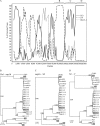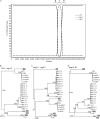Ecoepidemiology and complete genome comparison of different strains of severe acute respiratory syndrome-related Rhinolophus bat coronavirus in China reveal bats as a reservoir for acute, self-limiting infection that allows recombination events
- PMID: 20071579
- PMCID: PMC2826035
- DOI: 10.1128/JVI.02219-09
Ecoepidemiology and complete genome comparison of different strains of severe acute respiratory syndrome-related Rhinolophus bat coronavirus in China reveal bats as a reservoir for acute, self-limiting infection that allows recombination events
Abstract
Despite the identification of severe acute respiratory syndrome-related coronavirus (SARSr-CoV) in Rhinolophus Chinese horseshoe bats (SARSr-Rh-BatCoV) in China, the evolutionary and possible recombination origin of SARSr-CoV remains undetermined. We carried out the first study to investigate the migration pattern and SARSr-Rh-BatCoV genome epidemiology in Chinese horseshoe bats during a 4-year period. Of 1,401 Chinese horseshoe bats from Hong Kong and Guangdong, China, that were sampled, SARSr-Rh-BatCoV was detected in alimentary specimens from 130 (9.3%) bats, with peak activity during spring. A tagging exercise of 511 bats showed migration distances from 1.86 to 17 km. Bats carrying SARSr-Rh-BatCoV appeared healthy, with viral clearance occurring between 2 weeks and 4 months. However, lower body weights were observed in bats positive for SARSr-Rh-BatCoV, but not Rh-BatCoV HKU2. Complete genome sequencing of 10 SARSr-Rh-BatCoV strains showed frequent recombination between different strains. Moreover, recombination was detected between SARSr-Rh-BatCoV Rp3 from Guangxi, China, and Rf1 from Hubei, China, in the possible generation of civet SARSr-CoV SZ3, with a breakpoint at the nsp16/spike region. Molecular clock analysis showed that SARSr-CoVs were newly emerged viruses with the time of the most recent common ancestor (tMRCA) at 1972, which diverged between civet and bat strains in 1995. The present data suggest that SARSr-Rh-BatCoV causes acute, self-limiting infection in horseshoe bats, which serve as a reservoir for recombination between strains from different geographical locations within reachable foraging range. Civet SARSr-CoV is likely a recombinant virus arising from SARSr-CoV strains closely related to SARSr-Rh-BatCoV Rp3 and Rf1. Such frequent recombination, coupled with rapid evolution especially in ORF7b/ORF8 region, in these animals may have accounted for the cross-species transmission and emergence of SARS.
Figures






References
-
- Brandão, P. E., K. Scheffer, L. Y. Villarreal, S. Achkar, N. Oliveira Rde, O. Fahl Wde, J. G. Castilho, I. Kotait, and L. J. Richtzenhain. 2008. A coronavirus detected in the vampire bat Desmodus rotundus. Braz. J. Infect. Dis. 12:466-468. - PubMed
-
- Chen, C. Y., Y. H. Ping, H. C. Lee, K. H. Chen, Y. M. Lee, Y. J. Chan, T. C. Lien, T. S. Jap, C. H. Lin, L. S. Kao, and Y. M. Chen. 2007. Open reading frame 8a of the human severe acute respiratory syndrome coronavirus not only promotes viral replication but also induces apoptosis. J. Infect. Dis. 196:405-415. - PMC - PubMed
Publication types
MeSH terms
Substances
LinkOut - more resources
Full Text Sources
Miscellaneous

